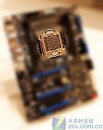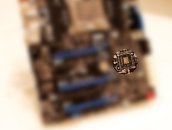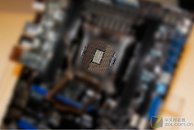- Joined
- Oct 9, 2007
- Messages
- 47,670 (7.43/day)
- Location
- Dublin, Ireland
| System Name | RBMK-1000 |
|---|---|
| Processor | AMD Ryzen 7 5700G |
| Motherboard | Gigabyte B550 AORUS Elite V2 |
| Cooling | DeepCool Gammax L240 V2 |
| Memory | 2x 16GB DDR4-3200 |
| Video Card(s) | Galax RTX 4070 Ti EX |
| Storage | Samsung 990 1TB |
| Display(s) | BenQ 1440p 60 Hz 27-inch |
| Case | Corsair Carbide 100R |
| Audio Device(s) | ASUS SupremeFX S1220A |
| Power Supply | Cooler Master MWE Gold 650W |
| Mouse | ASUS ROG Strix Impact |
| Keyboard | Gamdias Hermes E2 |
| Software | Windows 11 Pro |
Here are the first pictures of Intel's new high-end CPU socket, the 2011-pin land grid array (LGA2011). A selection of pictures of an unannounced motherboard by MSI made it to the internet. LGA2011, coupled with a new chipset, the Intel X68 Express, will drive the company's new high-end and enthusiast-grade processors that feature 6, 8, or 12 cores, and quad-channel DDR3 memory controllers. At first sight, the LGA2011 is huge! Its retention clip looks to be completely detachable by unhooking the retention bars on either sides. With all LGA sockets till date, you needed to unhook one retention bar, letting you open the retention clip along a hinge.
Since the processor has four DDR3 memory channels, there's room for only one DIMM per channel on a typically-sized ATX motherboard. On this particular motherboard, we can make out that there are two DIMM slots on either sides of the socket, accommodating two channels each. With this platform, Intel transferred the northbridge component completely to the CPU package, much like LGA1156/LGA1155. Therefore, the 32-lane PCI-Express controller is housed inside the CPU package. What remains of the chipset is a PCH (platform controller hub). Like P55/H55/P67/H67, the X68 is a PCH, a glorified southbridge. It will house a smaller PCI-E hub that handles various connectivity devices, a storage controller, a LPCIO controller, USB and HDA controllers, and the DMI link to the processor. We will get to know more about this platform as the year progresses.



View at TechPowerUp Main Site
Since the processor has four DDR3 memory channels, there's room for only one DIMM per channel on a typically-sized ATX motherboard. On this particular motherboard, we can make out that there are two DIMM slots on either sides of the socket, accommodating two channels each. With this platform, Intel transferred the northbridge component completely to the CPU package, much like LGA1156/LGA1155. Therefore, the 32-lane PCI-Express controller is housed inside the CPU package. What remains of the chipset is a PCH (platform controller hub). Like P55/H55/P67/H67, the X68 is a PCH, a glorified southbridge. It will house a smaller PCI-E hub that handles various connectivity devices, a storage controller, a LPCIO controller, USB and HDA controllers, and the DMI link to the processor. We will get to know more about this platform as the year progresses.



View at TechPowerUp Main Site





